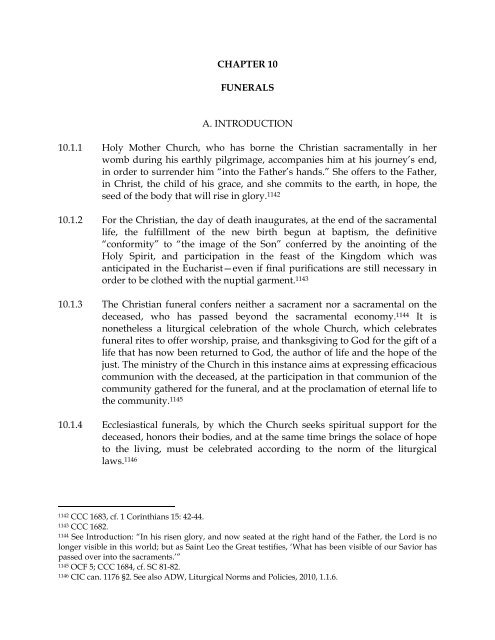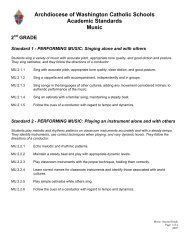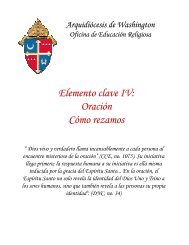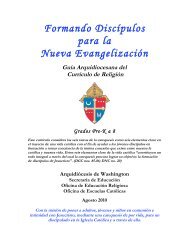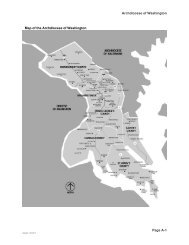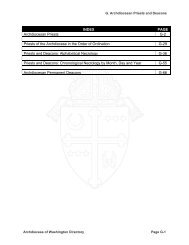10. Funerals - Archdiocese of Washington
10. Funerals - Archdiocese of Washington
10. Funerals - Archdiocese of Washington
You also want an ePaper? Increase the reach of your titles
YUMPU automatically turns print PDFs into web optimized ePapers that Google loves.
CHAPTER 10FUNERALSA. INTRODUCTION<strong>10.</strong>1.1 Holy Mother Church, who has borne the Christian sacramentally in herwomb during his earthly pilgrimage, accompanies him at his journey’s end,in order to surrender him “into the Father’s hands.” She <strong>of</strong>fers to the Father,in Christ, the child <strong>of</strong> his grace, and she commits to the earth, in hope, theseed <strong>of</strong> the body that will rise in glory. 1142<strong>10.</strong>1.2 For the Christian, the day <strong>of</strong> death inaugurates, at the end <strong>of</strong> the sacramentallife, the fulfillment <strong>of</strong> the new birth begun at baptism, the definitive“conformity” to “the image <strong>of</strong> the Son” conferred by the anointing <strong>of</strong> theHoly Spirit, and participation in the feast <strong>of</strong> the Kingdom which wasanticipated in the Eucharist—even if final purifications are still necessary inorder to be clothed with the nuptial garment. 1143<strong>10.</strong>1.3 The Christian funeral confers neither a sacrament nor a sacramental on thedeceased, who has passed beyond the sacramental economy. 1144 It isnonetheless a liturgical celebration <strong>of</strong> the whole Church, which celebratesfuneral rites to <strong>of</strong>fer worship, praise, and thanksgiving to God for the gift <strong>of</strong> alife that has now been returned to God, the author <strong>of</strong> life and the hope <strong>of</strong> thejust. The ministry <strong>of</strong> the Church in this instance aims at expressing efficaciouscommunion with the deceased, at the participation in that communion <strong>of</strong> thecommunity gathered for the funeral, and at the proclamation <strong>of</strong> eternal life tothe community. 1145<strong>10.</strong>1.4 Ecclesiastical funerals, by which the Church seeks spiritual support for thedeceased, honors their bodies, and at the same time brings the solace <strong>of</strong> hopeto the living, must be celebrated according to the norm <strong>of</strong> the liturgicallaws. 11461142 CCC 1683, cf. 1 Corinthians 15: 42-44.1143 CCC 1682.1144 See Introduction: “In his risen glory, and now seated at the right hand <strong>of</strong> the Father, the Lord is nolonger visible in this world; but as Saint Leo the Great testifies, ‘What has been visible <strong>of</strong> our Savior haspassed over into the sacraments.’”1145 OCF 5; CCC 1684, cf. SC 81-82.1146 CIC can. 1176 §2. See also ADW, Liturgical Norms and Policies, 2010, 1.1.6.
<strong>10.</strong>1.5 As soon as possible after the notification <strong>of</strong> death, the priest should call on thebereaved, whether at home or in the hospital, to console them and pray withthem. In the absence <strong>of</strong> a priest, members <strong>of</strong> the parish who are suitablyprepared for this ministry are encouraged to share in this responsibility.B. OFFICES AND MINISTRIES<strong>10.</strong>2.1 Priests, as teachers <strong>of</strong> faith and ministers <strong>of</strong> comfort, preside at the funeralrites, especially the Mass; the celebration <strong>of</strong> the funeral liturgy is especiallyentrusted to pastors and parochial vicars. When no priest is available,deacons, as ministers <strong>of</strong> the Word, <strong>of</strong> the altar, and <strong>of</strong> charity, preside atfuneral rites. 1147<strong>10.</strong>2.2 In the United States, white, violet, or black vestments may be worn at thefuneral rites and at other <strong>of</strong>fices and Masses for the dead. 1148<strong>10.</strong>2.3 When no priest or deacon is available for the vigil and related rites or the rite<strong>of</strong> committal, a layperson may preside. 1149<strong>10.</strong>2.4 Pastors and other priests should instill in readers, altar servers, musicians,ushers, pallbearers, and, according to existing norms, extraordinary ministers<strong>of</strong> Holy Communion, an appreciation <strong>of</strong> how much the reverent exercise <strong>of</strong>their ministries contributes to the celebration <strong>of</strong> the funeral rites. Familymembers should be encouraged to take an active part in these ministries, butthey should not be asked to assume any role that their grief or sense <strong>of</strong> lossmay make too burdensome. 1150<strong>10.</strong>2.5 Lectors or readers designated to proclaim the Word <strong>of</strong> God should preparethemselves to exercise this ministry. 1151<strong>10.</strong>2.6 The reading <strong>of</strong> Scripture during a Eucharistic celebration in the CatholicChurch is to be done by Catholics. On exceptional occasions and for a just1147 OCF 14.1148 OCF 39; GIRM 346. See also ADW, Liturgical Norms and Policies, 2010, 1.3.3.e.1149 OCF 14. While the rite permits the designation <strong>of</strong> a lay person to lead the prayers at the cemetery ormausoleum, this must be regarded as a rare exception in the <strong>Archdiocese</strong> <strong>of</strong> <strong>Washington</strong>, one that is to beemployed only in those circumstances when it is impossible for a priest or deacon to be present. In such acase, the designated lay person would not bless the grave.1150 OCF 15.1151 OCF 24.
cause, the Archbishop may permit a baptized non-Catholic to take on the task<strong>of</strong> reader. 1152<strong>10.</strong>2.7 The Word <strong>of</strong> God should always be proclaimed from a Lectionary, and neverfrom a disposable missalette or sheet <strong>of</strong> paper. Such temporary aids give poortestimony to the permanency and reverence due to the Word <strong>of</strong> God.Therefore, in proceeding to the ambo or lectern to proclaim the reading, thelector or reader should not carry a missalette or sheet <strong>of</strong> paper on which thereading has been written. 1153C. THOSE TO WHOM ECCLESIASTICAL FUNERALSMAY BE GRANTED<strong>10.</strong>3.1 Deceased members <strong>of</strong> the Christian faithful must be given ecclesiasticalfunerals according to the norm <strong>of</strong> law. 1154<strong>10.</strong>3.2 Manifest sinners can be granted ecclesiastical funerals in cases where therewill not be a public scandal <strong>of</strong> the faithful (for example, persons in irregularmarriages). 1155<strong>10.</strong>3.3 When it concerns funerals, catechumens must be counted among theChristian faithful. 1156<strong>10.</strong>3.4 Those who have expressed in some way their desire to receive baptism, eventhough they have not been received formally into the catechumenate, may becounted as catechumens, since they would have been entitled to baptism indanger <strong>of</strong> death. 1157<strong>10.</strong>3.5 The local ordinary can permit children whom the parents intended to baptizebut who died before baptism to be given ecclesiastical funerals. 11581152 ED 133, cf. CDW, Non-Catholic Readers at Mass. See also ADW, Liturgical Norms and Policies, 2010,6.9.5.1153 See ADW, Liturgical Norms and Policies, 2010, 1.4.8 and its note; 6.27.1.1154 CIC can. 1176 §1.1155 CIC can. 1184 §1 3 o . See also ADW, Liturgical Norms and Policies, 2010, <strong>10.</strong>4.1-7.1156 CIC can. 1183 §1.1157 José Tomás Martín de Agar, in Code <strong>of</strong> Canon Law Annotated, second edition (Montréal: Wilson andLafleur Lte., 2004) 918-919. José Luis Santos, in Exegetical Commentary on the Code <strong>of</strong> Canon Law (Montréal:Wilson and Lafleur Lte., 2004) III/2, 1697: “Even though the person may not be in the specific institutioncalled the “catechumenate ... it may be noted that this broader catechumen status is considered to besufficient for spiritual assistance, since upon defining it, the legislator does not speak <strong>of</strong> the institution,but <strong>of</strong> the individual’s genuine desire and personal will to join the Church.”1158 CIC can. 1183 §2.
<strong>10.</strong>3.6 In the prudent judgment <strong>of</strong> the local ordinary, the funeral rites <strong>of</strong> the CatholicChurch may be granted to members <strong>of</strong> a non-Catholic Church or ecclesialcommunity, unless it is evidently contrary to their will and provided thattheir own minister is unavailable. 1159 (Their own minister is consideredunavailable if they have not participated in their own denomination for sometime.) If a Funeral Mass is to be celebrated, the name <strong>of</strong> the deceased shouldnot be mentioned in the Eucharistic Prayer, since such commemorationpresupposes full communion with the Catholic Church. 1160<strong>10.</strong>3.7 Certainly those baptized non-Catholics who have expressed the desire to bereceived into full communion with the Catholic Church may be granted theChurch’s funeral rites.<strong>10.</strong>3.8 Unbaptized persons who in some way were considered to be close to theChurch but who died before receiving baptism can also be given anecclesiastical funeral, according to the prudent judgment <strong>of</strong> the localordinary. 1161D. THOSE TO WHOM ECCLESIASTICAL FUNERALSMUST BE DENIED<strong>10.</strong>4.1 Unbaptized persons who were not catechumens and who do not fall underthe provisions in the articles above are not given ecclesiastical funerals.However, it is permitted for a Catholic minister to <strong>of</strong>fer prayers for them, forexample, at the graveside. 1162<strong>10.</strong>4.2 Unless they gave some signs <strong>of</strong> repentance before death, notorious apostates,must be deprived <strong>of</strong> ecclesiastical funerals. 1163 (Apostasy is the totalrepudiation <strong>of</strong> the Christian faith. 1164 An apostate from the faith incurs a lataesententiae excommunication. 1165 )1159 CIC cann. 1183 §3, 1184; ED 120, cf. also CCEO, cann. 876 1, 887. ED 137: “[I]f priests, ministers orcommunities not in full communion with the Catholic Church do not have a place or the liturgical objectsnecessary for celebrating worthily their religious ceremonies, the diocesan Bishop may allow them theuse <strong>of</strong> a church or a Catholic building and also lend them what may be necessary for their services. Undersimilar circumstances, permission may be given to them for interment or for the celebration <strong>of</strong> services atCatholic cemeteries.”1160 CDF, On Public Mass for Deceased Non-Catholic Christians, 11 June 1976.1161 CCEO can. 876 §2; cf. CIC can. 19.1162 See ADW, Liturgical Norms and Guidelines, 2010, <strong>10.</strong>3.8.1163 CIC can. 1184 §1 1 o .1164 CIC can. 751.1165 CIC can. 1364 §1.
<strong>10.</strong>4.3 Unless they gave some signs <strong>of</strong> repentance before death, notorious hereticsmust be deprived <strong>of</strong> ecclesiastical funerals. 1166 (Heresy is the obstinate denialor obstinate doubt after the reception <strong>of</strong> baptism <strong>of</strong> some truth which is to bebelieved by divine and Catholic faith. 1167 A heretic incurs a latae sententiaeexcommunication. 1168 )<strong>10.</strong>4.4 Unless they gave some signs <strong>of</strong> repentance before death, notoriousschismatics must be deprived <strong>of</strong> ecclesiastical funerals. 1169 (Schism is therefusal <strong>of</strong> submission to the Supreme Pontiff or <strong>of</strong> communion with themembers <strong>of</strong> the Church subject to him. 1170 A schismatic incurs a lataesententiae excommunication. 1171 )<strong>10.</strong>4.5 Unless they gave some signs <strong>of</strong> repentance before death, those who arepublicly known to have chosen the cremation <strong>of</strong> their bodies for reasonscontrary to Christian faith must be deprived <strong>of</strong> ecclesiastical funerals. 1172<strong>10.</strong>4.6 Unless they gave some signs <strong>of</strong> repentance before death, other manifestsinners who cannot be granted ecclesiastical funerals without public scandal<strong>of</strong> the faithful must be deprived <strong>of</strong> ecclesiastical funerals. 1173<strong>10.</strong>4.7 If any doubt occurs, the local ordinary is to be consulted, and his judgmentmust be followed. 1174GeneralE. LITURGICAL RITES<strong>10.</strong>5.1 The Order <strong>of</strong> Christian <strong>Funerals</strong> gives three types <strong>of</strong> funeral celebrations,corresponding to the three places in which they are conducted—the home,the church, and the cemetery—and according to the importance attached tothem by the family, local customs, the culture, and popular piety. This order<strong>of</strong> celebration is common to all the liturgical traditions and comprises fourprincipal elements:1166 CIC can. 1184 §1 1 o .1167 CIC can. 751.1168 CIC can. 1364 §1.1169 CIC can. 1184 §1 1 o .1170 CIC can. 751.1171 CIC can. 1364 §1.1172 CIC can. 1184 §1 2 o ; cf. José Tomás Martín de Agar, in Code <strong>of</strong> Canon Law Annotated, second edition(Montréal: Wilson and Lafleur, Lte., 2004) 919.1173 CIC can. 1184 §1 3 o .1174 CIC can. 1184 §2.
a. the greeting <strong>of</strong> the community; 1175b. the reading <strong>of</strong> the Word <strong>of</strong> God; 1176c. the celebration <strong>of</strong> the Eucharistic sacrifice; 1177 andd. the farewell to the deceased. 1178<strong>10.</strong>5.2 A funeral Mass is one celebrated in the presence <strong>of</strong> the body, usually inconnection with the burial. It may be celebrated on all days except thosenoted in the Table <strong>of</strong> Permissibility <strong>of</strong> the <strong>Archdiocese</strong> <strong>of</strong> <strong>Washington</strong>Ordo. 1179<strong>10.</strong>5.3 Masses “after receiving the news <strong>of</strong> death,” for final burial, and on the firstanniversary, are the three special cases that are privileged and referred to inthe Table <strong>of</strong> Permissibility <strong>of</strong> the <strong>Archdiocese</strong> <strong>of</strong> <strong>Washington</strong> Ordo. All otherMasses <strong>of</strong> the dead are to be considered as “daily” Masses <strong>of</strong> the dead. 1180<strong>10.</strong>5.4 The correct title for the Mass celebrated prior to interment is “Funeral Mass”or “Mass <strong>of</strong> Christian Burial.” The term “Mass <strong>of</strong> the Resurrection,” althoughit emphasizes the festive tone <strong>of</strong> the resurrection, is inaccurate and should notbe used, inasmuch as it causes confusion with the celebration <strong>of</strong> Easteritself. 1181Place for <strong>Funerals</strong><strong>10.</strong>6.1 A funeral for any deceased member <strong>of</strong> the faithful must generally becelebrated in his or her parish church. A funeral Mass is never to becelebrated at a funeral home or in the chapel <strong>of</strong> a cemetery. 1182<strong>10.</strong>6.2 Any member <strong>of</strong> the faithful or those competent to take care <strong>of</strong> the funeral <strong>of</strong> adeceased member <strong>of</strong> the faithful are permitted to choose another church for1175 CCC 1687.1176 CCC 1688.1177 CCC 1689.1178 CCC 1690.1179 ADW Ordo 14. See also ADW, Liturgical Norms and Policies, 2010, <strong>10.</strong>7.1.1180 ADW Ordo 15. Daily Mass for the dead may be said only when the Mass is actually being applied fora deceased person on a weekday <strong>of</strong> Ordinary Time. Ibid., 16.1181 BCLN April 1973.1182 CIC can. 1177 §1; OCF 268.
the funeral rite with the consent <strong>of</strong> the person who governs it and afternotification <strong>of</strong> the proper pastor <strong>of</strong> the deceased. 1183Planning<strong>10.</strong>7.1 A funeral Mass may be celebrated on any day except for solemnities that areholy days <strong>of</strong> obligation, Holy Thursday, the Easter Triduum, and the Sundays<strong>of</strong> Advent, Lent, and Easter, with due regard also for all the otherrequirements <strong>of</strong> the norm <strong>of</strong> the law. 1184<strong>10.</strong>7.2 In the arranging and choosing <strong>of</strong> the variable parts <strong>of</strong> the funeral liturgy (e.g.,orations, readings, Prayer <strong>of</strong> the Faithful), pastoral considerations bearingupon the deceased, the family, and those attending should rightly be takeninto account. 1185<strong>10.</strong>7.3 In preparing to celebrate the funeral <strong>of</strong> an infant or child, pastors are stronglyencouraged to read closely the introduction to this section <strong>of</strong> the Order <strong>of</strong>Christian <strong>Funerals</strong>. Especially at the death <strong>of</strong> a child, the Christiancommunity seeks to <strong>of</strong>fer support and consolation to the parents and familyduring and after the time <strong>of</strong> the funeral rites. Those adults who have lostchildren <strong>of</strong> their own are to be especially encouraged to support the bereavedin their struggle to accept the death <strong>of</strong> a child. In the preparation <strong>of</strong> a FuneralMass for a deceased child, if it is foreseen that many children will be present,the principles contained in the Directory for Masses with Children may beconsidered. 1186<strong>10.</strong>7.4 The faithful, and especially the family <strong>of</strong> the deceased, should be urged toparticipate in the Eucharistic Sacrifice <strong>of</strong>fered for the deceased person also byreceiving Holy Communion. 1187<strong>10.</strong>7.5 Ministers should be aware that the experience <strong>of</strong> death can bring about in themourners possible needs for reconciliation. With attentiveness to eachsituation, the minister can help to begin the process <strong>of</strong> reconciliation. In somecases this process may find expression in the celebration <strong>of</strong> the sacrament <strong>of</strong>penance, either before the funeral liturgy or at a later time. 11881183 CIC can. 1177 §2.1184 GIRM 380; cf. CIC cann. 1176-1185. See also ADW, Liturgical Norms and Policies, <strong>10.</strong>5.2.1185 GIRM 385.1186 OCF, 28, 238, 240.1187 GIRM 383.1188 OCF 53.
Vigil or Wake Service<strong>10.</strong>8.1 The vigil for the deceased is the principal rite celebrated by the Christiancommunity before the funeral liturgy, or, if there is no funeral liturgy, beforethe rite <strong>of</strong> committal. The vigil may take the form <strong>of</strong>a. a Liturgy <strong>of</strong> the Word, provided in the Order <strong>of</strong> Christian <strong>Funerals</strong> asi. the Vigil for the Deceased, 1189 orii. the Vigil for the Deceased with Reception at the Church. 1190b. some part <strong>of</strong> the <strong>of</strong>fice for the dead, provided in the Order <strong>of</strong>Christian <strong>Funerals</strong> in Part IV. 1191<strong>10.</strong>8.2 The vigil may be celebrated in the home <strong>of</strong> the deceased, in the funeral home,parlor, or chapel <strong>of</strong> rest, or in some other suitable place. It may also becelebrated in the church, but at a time well before the funeral liturgy, so thatthe funeral liturgy will not be lengthy and the Liturgy <strong>of</strong> the Wordrepetitious. Adaptations <strong>of</strong> the vigil will <strong>of</strong>ten be suggested by the place inwhich the celebration occurs. A celebration in the home <strong>of</strong> the deceased, forexample, may be simplified and shortened. If the reception <strong>of</strong> the body at thechurch is celebrated apart from the vigil or the funeral liturgy, the “Vigil forthe Deceased with Reception at the Church” may be used and simplified. 1192<strong>10.</strong>8.3 Catholics have long treasured the practice <strong>of</strong> praying the rosary at wakes orvigil services. While no mention is made <strong>of</strong> the rosary in the vigil described inthe Order <strong>of</strong> Christian <strong>Funerals</strong>, the practice <strong>of</strong> praying the rosary is not to bediscouraged, but rather encouraged as a way for the family and friends topray together either before or after the vigil, which should be regarded as themain service <strong>of</strong> prayer.<strong>10.</strong>8.4 When the vigil service takes place in church, the pastor must be assured thatsomeone <strong>of</strong> the family is present at all times with the body while the church isopen. Reverence for the sacred character <strong>of</strong> the church should be observed.The body <strong>of</strong> the deceased must never be left unguarded.<strong>10.</strong>8.5 After the vigil service is over the church must be securely locked to preventany possible desecration <strong>of</strong> the body. Jewelry or other valuables should not be1189 OCF 69-81.1190 OCF 82-97.1191 OCF 54.1192 OCF 55.
left on the body overnight. The pastor should also consider the schedule <strong>of</strong>Masses which are celebrated in the church, and if provisions are possible formoving the body prior to those Masses. 1193Funeral Liturgy<strong>10.</strong>9.1 The Church <strong>of</strong>fers the Eucharistic Sacrifice <strong>of</strong> Christ’s Passover for the deadso that, since all the members <strong>of</strong> Christ’s body are in communion with eachother, the petition for spiritual help on behalf <strong>of</strong> some may bring comfortinghope to others. 1194<strong>10.</strong>9.2 Among the Masses for the Dead, the Funeral Mass holds first place. It may becelebrated on any day except for Solemnities that are holy days <strong>of</strong> obligation,Holy Thursday, the Easter Triduum, and the Sundays <strong>of</strong> Advent, Lent, andEaster, with due regard also for all the other requirements <strong>of</strong> the norm <strong>of</strong> thelaw. 1195<strong>10.</strong>9.3 The faithful, and especially the family <strong>of</strong> the deceased, should be urged toparticipate in the Eucharistic Sacrifice <strong>of</strong>fered for the deceased person also byreceiving Holy Communion. 1196<strong>10.</strong>9.4 Only Christian symbols may rest on or be placed near the c<strong>of</strong>fin during thefuneral liturgy. Any other symbols, for example, national flags, or flags orinsignia <strong>of</strong> associations, are to be removed from the c<strong>of</strong>fin at the entrance <strong>of</strong>the church, and may be replaced after the c<strong>of</strong>fin has been taken from thechurch. 1197<strong>10.</strong>9.5 If the Funeral Mass is directly joined to the burial rite, once the prayer afterCommunion has been said and omitting the concluding rite, the rite <strong>of</strong> finalcommendation or farewell takes place. This rite is celebrated only if the bodyis present. 11981193 BLS 114.1194 GIRM 379.1195 GIRM 380, cf. CIC cann. 1176-1185.1196 GIRM 383.1197 OCF 38, 132. During the Mass the flag may be given a place <strong>of</strong> honor near the body, as a sign <strong>of</strong>respect for the deceased person’s civil role.1198 GIRM 384.
Homily<strong>10.</strong><strong>10.</strong>1 At funeral rites there should, as a rule, be a short homily. 1199 Attentive to thegrief <strong>of</strong> those present, the homilist should dwell on God’s compassionate loveand on the Paschal Mystery <strong>of</strong> the Lord, as proclaimed in the Scripturereadings. The homilist should help the members <strong>of</strong> the assembly tounderstand that the mystery <strong>of</strong> God’s love and the mystery <strong>of</strong> Jesus’victorious death and resurrection were present in the life and death <strong>of</strong> thedeceased, and that these mysteries are active in their own lives as well.Through the homily members <strong>of</strong> the family and community should receiveconsolation and strength to face the death <strong>of</strong> one <strong>of</strong> their members with ahope nourished by the saving Word <strong>of</strong> God. 1200<strong>10.</strong><strong>10.</strong>2 At the same time, the homily and prayers for the deceased should not bephrased so as to imply that the deceased is already in heaven. The homilymust “avoid the literary genre <strong>of</strong> funeral eulogy” and illumine the mystery <strong>of</strong>Christian death in the light <strong>of</strong> the risen Christ. The Catholic doctrinesregarding purgatory and indulgences must be respected, and mention can bemade <strong>of</strong> the propriety <strong>of</strong> <strong>of</strong>fering Masses and other prayers and good worksas intercessions for the departed. 1201<strong>10.</strong><strong>10.</strong>3 Pastors should take into special account those who are present at a liturgicalcelebration who hear the Gospel on the occasion <strong>of</strong> the funeral and who maybe non-Catholics, or Catholics who never or rarely participate in theEucharist, or who seem even to have lost the faith, for priests are ministers <strong>of</strong>Christ’s Gospel for all, and this can be an opportunity for catechesis. 1202Words <strong>of</strong> Remembrance, and “Eulogies”<strong>10.</strong>11.1 While the Order <strong>of</strong> Christian <strong>Funerals</strong> allows the option to permit a familymember or friend to speak in remembrance <strong>of</strong> the deceased at a funeralliturgy, there must never be a eulogy <strong>of</strong> any kind. A eulogy is “a speech orwriting in praise <strong>of</strong> a person,” a “commendatory oration,” and thus has neverbeen a part <strong>of</strong> the Catholic liturgical tradition. But because eulogies have been1199 By definition, the homily is <strong>of</strong>fered only by a priest or deacon. A lay person who presides at a funeralrite gives an “instruction on the readings.” OCF 27. See also ADW, Liturgical Norms and Policies, 2010,1.9.1-5.1200 OCF 27, 61, 77, 93, 141, 166, 192, 259, 284, 304; CCC 1688, cf. OCF 41; GIRM 382.1201 GIRM 382; CCC 1030-1032, 1471-1479, 1688; OCF 41; MI, especially those grants pertaining to variousprayers for the departed. See also ADW, Liturgical Norms and Policies, 2010, 7.11.1-7.12.8, <strong>10.</strong>11.5.c.1202 GIRM 385; cf. OCF 27.
part <strong>of</strong> the funeral rites <strong>of</strong> other traditions, some Catholics now expect them—and expect to deliver them—at Catholic funeral liturgies. 1203<strong>10.</strong>11.2 Therefore, at the time that a funeral is being planned, when family membersand friends will be particularly sensitive, it will be important to explain in apastoral way the principles and proper focus <strong>of</strong> Catholic funeral rites, and thedifference between words <strong>of</strong> remembrance and eulogies. Such explanationscan be included in literature prepared in advance to assist those who mayhave to plan funeral rites. If words <strong>of</strong> remembrance are to be <strong>of</strong>fered, they areto be succinct, written, and discussed in advance with the celebrant andpastor.<strong>10.</strong>11.3 It should be explained that the most appropriate times for family membersand friends to <strong>of</strong>fer extended remarks about the deceased are:a. before or after a vigil or wake service—even one held in the churchbefore the start <strong>of</strong> the funeral liturgy;b. at the graveside, before or after the rite <strong>of</strong> committal; orc. at a reception, held before or after the funeral rites.It should be explained that these venues allow for more speakers, more time,more spontaneity, a wider range <strong>of</strong> themes and methods <strong>of</strong> paying tribute(stories, songs, or poems), and less emotional stress for the speaker(s). 1204Other ways <strong>of</strong> sharing memories <strong>of</strong> the deceased can be through a pamphletdistributed at one <strong>of</strong> these venues or at the funeral liturgy, or even through anelectronic document produced by family or friends and shared through theInternet.<strong>10.</strong>11.4 Nevertheless, according to their prudent judgment, pastors may exercise theoption contained in the Order <strong>of</strong> Christian <strong>Funerals</strong> to permit one familymember or friend to speak in remembrance <strong>of</strong> the deceased at a funeralliturgy, following the Prayer after Communion (or the Lord’s Prayer, if thereis no Mass) and before the final commendation. 12051203 OCF 27, 141, 170, 197, 288, 309, 382, 394; GIRM 382. In recent years many dioceses have issuedregulations to clarify liturgical law and to curb abuses.1204 OCF 15: “Family members … should not be asked to assume any role that their grief or sense <strong>of</strong> lossmay make too burdensome.” Diocese <strong>of</strong> Winona, “How to Plan a Catholic Funeral:” “Through thepresence <strong>of</strong> Christ found in the Eucharist, Scripture, the gathered faithful and the priest, the Funeral Massmoves us from intense grief and loss, to hopeful joy and peace. Having a sad or unrehearsed eulogy afterCommunion can tend to negate the prayer before it.”1205 OCF 170, 197.
<strong>10.</strong>11.5 In the cases described above, the words spoken in remembrance <strong>of</strong> thedeceased that are prepared and submitted in advance are:a. to be simple and brief, lasting no more than five minutes;b. to address solely the life <strong>of</strong> the deceased in relation to his or herCatholic faith; 1206 andc. to avoid any suggestion that the deceased is “in heaven,” which,among other things, implies that he or she is not in need <strong>of</strong> theprayers and suffrages <strong>of</strong> the Church. 1207<strong>10.</strong>11.6 Since, unlike the homily, words <strong>of</strong> remembrance form no part <strong>of</strong> the Liturgy<strong>of</strong> the Word, they should not be made from the pulpit or ambo, but are to begiven from some other appropriate place designated by the pastor. 12081206 These remarks must not include anything that is contrary to the Catholic faith, scandalous, <strong>of</strong>fensive,<strong>of</strong>f-color, or otherwise inappropriate to a celebration <strong>of</strong> Christian faith and hope in the context <strong>of</strong> aCatholic funeral liturgy.1207 CCC 1032; cf. MI, norms, 3; ibid., other concessions, 29. Pope Paul VI, Apostolic ConstitutionIndulgentiarum doctrina, (1967) 2-3, in MI: “It is a divinely revealed truth that sins bring punishmentsinflicted by God’s sanctity and justice. These must be expiated either on this earth through the sorrows,miseries and calamities <strong>of</strong> this life and above all through death, or else in the life beyond through fire andtorments or ‘purifying’ punishments…. These punishments are imposed by the just and mercifuljudgment <strong>of</strong> God for the purification <strong>of</strong> souls, the defense <strong>of</strong> the sanctity <strong>of</strong> the moral order and therestoration <strong>of</strong> the glory <strong>of</strong> God to its full majesty…. That punishment or the vestiges <strong>of</strong> sin may remain tobe expiated or cleansed and that they in fact frequently do even after the remission <strong>of</strong> guilt is clearlydemonstrated by the doctrine on purgatory. In purgatory, in fact, the souls <strong>of</strong> those ‘who died in thecharity <strong>of</strong> God and truly repentant, but before satisfying with worthy fruits <strong>of</strong> penance for sinscommitted and for omissions,’ are cleansed after death with purgatorial punishments. This is also clearlyevidenced in the liturgical prayers with which the Christian community admitted to Holy Communionhas addressed God since most ancient times: ‘that we, who are justly subjected to afflictions because <strong>of</strong>our sins, may be mercifully set free from them for the glory <strong>of</strong> thy name.’” MI, norms, 2: “An indulgenceis partial or plenary according to whether it removes either part or all <strong>of</strong> the temporal punishment duesin.” Idem, 3: “The faithful can obtain partial or plenary indulgences for themselves, or they can applythem to the dead by way <strong>of</strong> suffrage.” See also CCC 1030-1032, 1471-1479. DPP 251: “[The pious custom<strong>of</strong> suffrage for the souls <strong>of</strong> the faithful departed] is an urgent supplication <strong>of</strong> God to have mercy on thesouls <strong>of</strong> the dead, to purify them by the fire <strong>of</strong> His charity, and to bring them to His kingdom <strong>of</strong> light andlife. This suffrage is a cultic expression <strong>of</strong> faith in the communion <strong>of</strong> saints. Indeed, ‘the Church in itspilgrim members, from the very earliest days <strong>of</strong> the Christian religion, has honored with great respect thememory <strong>of</strong> the dead; and “because it is a holy and a wholesome thought to pray for the dead that theymay be loosed from their sins” (2 Mac 12: 46) she <strong>of</strong>fers her suffrages for them’ [LG 50]. These consist,primarily, in the celebration <strong>of</strong> the holy sacrifice <strong>of</strong> the Eucharist [Second Council <strong>of</strong> Lyons, Pr<strong>of</strong>essio fideiMichaelis Palaeologi imperatoris (1274): DS 856; Saint Cyprian, Epistula 1 2; Saint Augustine, Confessiones IX,12 32], and in other pious exercises, such as prayers for the dead, alms deeds, works <strong>of</strong> mercy [SaintAugustine, De curis pro mortuis gerenda 6; Saint John Chrysostom, Homilia in primam ad Corinthios 41 5],and the application <strong>of</strong> indulgences to the souls <strong>of</strong> the faithful departed.”
<strong>10.</strong>11.7 Pastors are authorized to establish, as a matter <strong>of</strong> policy for their parishes,whether the option to allow words <strong>of</strong> remembrance to be spoken at funeralliturgies will be used. Such policies should be made explicit in any literatureprepared for those who are planning funeral rites.Music<strong>10.</strong>12.1 Music for the celebration <strong>of</strong> funeral rites should be chosen with great care, sothat it will support, console, and uplift the participants. The texts <strong>of</strong> songsshould be related to the readings from Scripture, and should express thePaschal Mystery <strong>of</strong> the Lord’s suffering, death, and victory over death, andthe Christian’s share in that victory. 1209<strong>10.</strong>12.2 Secular songs and music <strong>of</strong> any kind, whether classical, popular, or patriotic,even if they were favorites <strong>of</strong> or requested by the deceased, are not to be usedin ecclesiastical funeral rites. As with any words <strong>of</strong> remembrance spoken byfamily members and friends, the appropriate venues for the singing orplaying <strong>of</strong> secular music are:a. before or after a vigil or wake service—even at one held in the churchbefore the start <strong>of</strong> the funeral liturgy;b. at the graveside, before or after the rite <strong>of</strong> committal; orc. at a reception, held before or after the funeral rites.BurialF. ECCLESIASTICAL BURIAL<strong>10.</strong>13.1 The Church earnestly recommends that the pious custom <strong>of</strong> burying thebodies <strong>of</strong> the deceased be observed. “This is the body once washed inbaptism, anointed with the oil <strong>of</strong> salvation, and fed with the bread <strong>of</strong> life. This1208 See GIRM 309: “From the ambo only the readings, the responsorial Psalm, and the EasterProclamation (Exsultet) are to be proclaimed; it may be used also for giving the homily and forannouncing the intentions <strong>of</strong> the Prayer <strong>of</strong> the Faithful. The dignity <strong>of</strong> the ambo requires that only aminister <strong>of</strong> the word should go up to it.” Ibid. 105b: “In performing this function the commentator standsin an appropriate place facing the faithful, but not at the ambo.” (Emphasis added.) See other references inthe same document to the proper uses <strong>of</strong> the ambo. In a case <strong>of</strong> true necessity (e.g., lack <strong>of</strong> space) a pastormay permit the use <strong>of</strong> the ambo for this purpose.1209 OCF 30.
is the body whose hands clothed the poor and embraced the sorrowing.Indeed, the human body is so inextricably associated with the human personthat it is hard to think <strong>of</strong> a human person apart from his or her body. Thus,the Church’s reverence and care for the body grows out <strong>of</strong> a reverence andconcern for the person whom the Church now commends to the care <strong>of</strong>God.” 1210<strong>10.</strong>13.2 Since the family unit traditionally has been preserved even in death, non-Catholics may be buried in Catholic cemeteries with Catholic familymembers.<strong>10.</strong>13.3 Due to possible legal implications, all burial arrangements should be made bythe family directly with the cemetery, rather than through the parish.<strong>10.</strong>13.4 If a parish has its own cemetery, the deceased members <strong>of</strong> the faithful are tobe buried in it unless the deceased or those competent to take care <strong>of</strong> theburial <strong>of</strong> the deceased have chosen legitimately another cemetery. 1211<strong>10.</strong>13.5 Everyone, however, is permitted to choose the cemetery <strong>of</strong> burial unlessprohibited by law. 1212 Similarly, Catholics may seek burial in a cemetery otherthan a Catholic one.<strong>10.</strong>13.6. Any Catholic member <strong>of</strong> the community has a right to this Christian burialregardless <strong>of</strong> ability to pay for such services.<strong>10.</strong>13.7 With the exception <strong>of</strong> the Cathedral <strong>of</strong> St. Matthew the Apostle, tombs,graves, mausoleums, or columbaria for cremated remains are not permittedin churches or chapels within the <strong>Archdiocese</strong> <strong>of</strong> <strong>Washington</strong>. 12131210 CIC can. 1176 §3; OCF 412. Saint Augustine, De curis pro mortuis gerenda 5: “The Lord Himself ... aboutto rise on the third day, both preaches, and commends to be preached, the good work <strong>of</strong> a religiouswoman, that she poured out a precious ointment over His limbs, and did it for His burial: and they arewith praise commemorated in the Gospel, who having received His Body from the cross did carefullyand with reverend honor see it wound and laid in the sepulchre. These authorities however do not put usupon thinking that there is in dead bodies any feeling; but rather, that the Providence <strong>of</strong> God (Who ismoreover pleased with such <strong>of</strong>fices <strong>of</strong> piety) does charge itself with the bodies also <strong>of</strong> the dead, this theybetoken, to the intent our faith <strong>of</strong> resurrection might be stayed up thereby.”1211 CIC can. 1180 §1.1212 CIC can. 1180 §2.1213 CIC cann. 1242-43.
Cremation<strong>10.</strong>14.1 The Church does not prohibit cremation unless it was chosen for reasonscontrary to Christian doctrine. Cremation, however, does not enjoy the samevalue as burial <strong>of</strong> the body. “The Church clearly prefers and urges that thebody <strong>of</strong> the deceased be present for the funeral rites, since the presence <strong>of</strong> thehuman body better expresses the values which the Church affirms in itsrites.” Therefore, it is earnestly recommended by the Conference <strong>of</strong> Bishopsthat cremation take place following the funeral liturgy. 1214<strong>10.</strong>14.2 Any catechesis on the subject <strong>of</strong> cremation should emphasize that “thecremated remains <strong>of</strong> a body should be treated with the same respect given tothe corporeal remains <strong>of</strong> a human body. This includes the use <strong>of</strong> a worthyvessel to contain the ashes, the manner in which they are carried, the care andattention to appropriate placement and transport, and the finaldisposition.” 1215<strong>10.</strong>14.3 A funeral Mass with the cremated remains present necessitates a dignifiedplace on which the remains can rest during the Mass. To avoid ritual use <strong>of</strong>makeshift carriers or other inappropriate containers, parishes may wish toobtain a well-designed urn or ceremonial vessel and stand to hold thecremated remains during the vigil and funeral. 1216<strong>10.</strong>14.4 Cremated remains should be reverently buried or entombed in a cemetery,mausoleum, or columbarium; they may also be buried in a common grave ina cemetery. 1217<strong>10.</strong>14.5 Cremated remains may be properly buried at sea in the urn, c<strong>of</strong>fin or othercontainer in which they have been carried to the place <strong>of</strong> committal. Whilecremated remains may be buried at sea, “the practice <strong>of</strong> scattering crematedremains on the sea, from the air, or on the ground, or keeping crematedremains in the home <strong>of</strong> a relative or friend <strong>of</strong> the deceased are not thereverent disposition that the Church requires.” 12181214 CIC can. 1176 §3; OCF 212, 413; BCL, Reflections on the Body, Cremation, and Catholic Funeral Rites,1997. Prior to the change in discipline regarding the presence <strong>of</strong> cremated remains in the church, Notitiae,13, January 1977, published an article that stated, “In fact, the ashes which are an expression <strong>of</strong> thecorruptibility <strong>of</strong> the human body are unable to express the inherent character <strong>of</strong> one ‘sleeping,’ awaitingthe resurrection. The body, not the ashes, receives liturgical honors since it was made the temple <strong>of</strong> theSpirit <strong>of</strong> God in baptism. It is important to respect the verity <strong>of</strong> the sign in order that the liturgicalcatechesis and the celebration itself be authentic and fruitful.”1215 BCLN July 1999, cf. OCF 416.1216 BLS 113.1217 OCF 417.1218 BCLN July 1999, cf. OCF 416-417.
G. RECORD OF DEATH AND BURIAL<strong>10.</strong>15.1 When a burial has been completed, a record is to be made in the parishregister <strong>of</strong> deaths. 12191219 CIC can. 1182. See also ADW, Liturgical Norms and Policies, 2010, 1.12.4.g.


